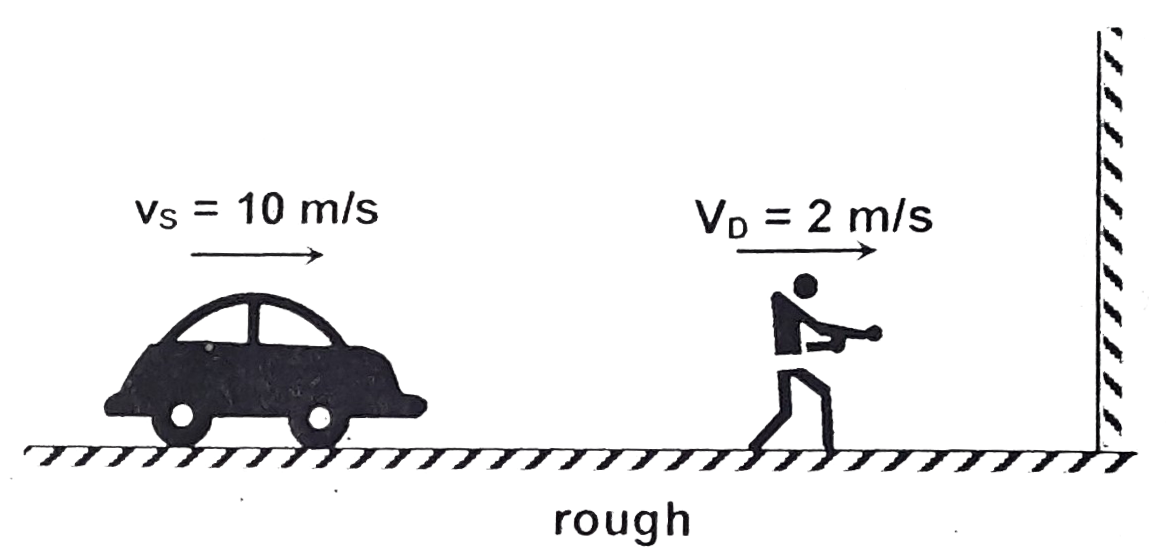A car is initially at rest, 330 m away from a stationary observer. It begins to move towards the observer with an acceleration of 1.1ms−2 sounding its horn continuously. 20 s later, the driver stops sounding the horn. The velocity of sound in air is 330ms−1. The observer will hear the sound of the horn for a duration of
20 s
21 s
2023s
1913s
The correct Answer is:D
To solve the problem step by step, we need to determine how long the observer will hear the sound of the horn after the car starts moving towards them.
Step 1: Calculate the displacement of the car in 20 seconds
The car starts from rest and accelerates towards the observer. The formula for displacement under constant acceleration is given by:
s=ut+12at2
Where:
- s = displacement
- u = initial velocity (0 m/s, since the car starts from rest)
- a = acceleration (1.1 m/s²)
- t = time (20 s)
Substituting the values:
s=0⋅20+12⋅1.1⋅(20)2
s=12⋅1.1⋅400
s=220 m
Step 2: Determine the new distance of the car from the observer after 20 seconds
Initially, the car was 330 m away from the observer. After 20 seconds, the car has moved 220 m closer.
New distance=330 m−220 m=110 m
Step 3: Calculate the time taken for the sound to reach the observer
The sound travels at a speed of 330 m/s. The time taken for the sound to travel 110 m is given by:
t=distancespeed=110 m330 m/s=13 s
Step 4: Calculate the total time the observer hears the horn
The horn is sounded for 20 seconds, and the sound takes an additional 13 seconds to reach the observer after the horn stops.
Thus, the total time T that the observer hears the horn is:
T=20 s+13 s=2013 s
Final Answer
The observer will hear the sound of the horn for a duration of 2013 seconds.
---
The car starts from rest and accelerates towards the observer. The formula for displacement under constant acceleration is given by:
- s = displacement
- u = initial velocity (0 m/s, since the car starts from rest)
- a = acceleration (1.1 m/s²)
- t = time (20 s)
s=12⋅1.1⋅400
s=220 m
Initially, the car was 330 m away from the observer. After 20 seconds, the car has moved 220 m closer.
The sound travels at a speed of 330 m/s. The time taken for the sound to travel 110 m is given by:
The horn is sounded for 20 seconds, and the sound takes an additional 13 seconds to reach the observer after the horn stops.
The observer will hear the sound of the horn for a duration of 2013 seconds.
Topper's Solved these Questions
Similar Questions
if the velocity of sound in helium at room temperature is 330 m/s, then the velocity of sound in hydrogen is
View SolutionThe velocity of sound in air at 27∘C is 330 m/s. the velocity of sound when the temperature of the gas is raised to 227∘C is
View SolutionThe velocity of sound in air at NTP is 330 m/s. What will be its value when temperature is doubled and pressure is halved ?
View SolutionA car is moving with a constant velocity 10m/s towards the stationary wall. The car blows a horn of frequency 320Hz. The velocity of sound in air is 330m/s. The beats frequency received by the observer is
 View Solution
View SolutionAn observer A fires a gun and another observer B at a distance 1650 m away from A hears its sound. If the speed of sound is 330 m s−1, find the time when B will hear the sound after firing by A.
View Solutiona bus is moving with a velocity 4 m/s towards a wall, the driver sounds a horn of frequency 173 Hz . if the speed of sound in air is 350 m/s. the number of beat heard per second by a passanger on the bus will be
View SolutionThe time interval between a lightning flash and the first sound of thunder is 5 s. If the speed of sound in air is 330 m s−1, find the distance of flash from the observer.
View SolutionAt room temperature (27∘C) the velocity of sound in air is 330 m/s. the increase in velocity of sound when temperature is increased by 1∘C is
View SolutionThe driver of a car travelling with speed 30ms−1 towards a hill sounds a horn of frequency 600 Hz. If the velocity of sound in air is 330ms−1, the frequency of reflected sound as heard by driver is
View SolutionThe ratio of the apparent frequencies of a car when approaching and receding a stationary observer is 11:9 What is the speed of the car, if the velocity of sound in air is 330 m/s?
View Solution

